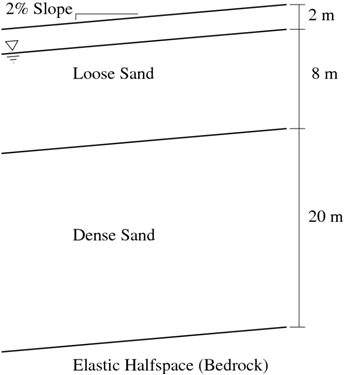Three-Dimensional Site Response Analysis of Sloping Ground
Example prepared by: Christopher McGann and Pedro Arduino, University of Washington
Return to OpenSees Examples Page
This article discusses a three-dimensional effective stress site response analysis of a slope using OpenSees. The considered site consists of layered cohesionless soil underlain by bedrock. The slope has a 2% grade perpendicular to the direction of shaking. The model consists of a single column of 3D brick elements supported vertically at the base. Periodic boundary conditions are applied in both horizontal directions. A Lysmer-Kuhlemeyer (1969) dashpot is utilized to account for the finite rigidity of the underlying elastic medium, and the loading is applied in a manner consistent with that proposed by Joyner and Chen (1975).
Provided with this article are several files. Files which are required for the analysis are indicated. The files include:
- The example input file, freeField3D.tcl (required for analysis)
- The velocity time history of the selected earthquake record, yerbaNSvelocity.out (required for analysis)
- A GiD post-process mesh file, freeField3D.flavia.msh (generated automatically by running freeField3D.tcl)
- A Matlab script, flaviaWriter.m, which can be used to reformat the recorded output from OpenSees into a file which can be read by GiD for post-process visulization. Non-Matlab users may find the process represented by this file useful in creating an alternative means for accomplishing this reformatting.
- The post-process results file, freeField3D.flavia.res, which is generated through the use of the flaviaWriter.m script. This file, combined with the file freeField3D.flavia.msh, allows the user to visualize the results of the site response analysis using GiD.
All of the files mentioned above can be downloaded here.
To run this example, the user must download the input file, freeField3D.tcl, and the velocity time history file, yerbaNSvelocity.out, and place them in a single directory. The additional files described above are not essential to the analysis. They are provided to demonstrate how to use the GiD tool to visualize results from this type of analysis.
For further information into a site response analysis using OpenSees, the user is referred to the 2D total stress site response analysis example, the 2D effective stress site response analysis example, and the set of examples developed at UCSD available here.
Model Description

The site response analysis discussed in this article is for a soil profile consisting of a 10 m thick layer of loose sand (Dr = 40%) above a 20 m thick layer of more dense sand (Dr = 75%). The profile is assumed to be on an infinite slope with a 2% grade. A schematic representation of the analyzed soil profile is shown in Fig. 1. The entire soil profile is underlain by an elastic half-space which represents the finite rigidity of an underlying bedrock layer. The groundwater table is located at a depth of 2 m. Earthquake excitation is applied in the direction perpendicular to the slope.
Mesh Geometry
The input file freeField3D.tcl is set-up in a manner such that the user need only define the geometry of the soil layers and groundwater table along with the number of elements (vertically) within each layer. Note: if the ground water table is not located at the surface, an additional soil layer must be included to differentiate the dry or moist soil above the gwt from the saturated soil below the gwt. The default values are for the soil profile shown in Fig. 1, with 0.5 m high elements. A single column of 8-node brick elements is created based off of the input information. The vertical direction for this column is oriented with the global y-direction.
Boundary Conditions
Material and Element Definitions
Recorders
Loading and Analysis
Results
GiD Visualization
References
- Joyner, W.B. and Chen A.T.F. (1975) "Calculation of nonlinear ground response in earthquakes," Bulletin of the Seismological Society of America, 65(5), 1315-1336.
- Kramer, S.L. (1996). Geotechnical Earthquake Engineering. Prentice Hall, Upper Saddle River, NJ.
- Lysmer, J. and Kuhlemeyer, A.M. (1969). "Finite dynamic model for infinite media," Journal of the Engineering Mechanics Division, ASCE, 95, 859-877.